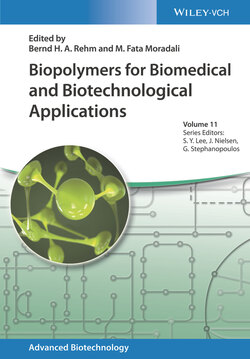Читать книгу Biopolymers for Biomedical and Biotechnological Applications - Группа авторов - Страница 11
1.2 Biocompatibility Evaluation of Biopolymeric Materials and Devices
ОглавлениеBiopolymers represent a special subset of materials useful in medicine, being derived or produced by living organisms or synthesized from basic biological building blocks. Compared with synthetic polymers, the advantages from the perspective of biocompatibility are clear: because these materials are made by living systems, from building blocks ubiquitous to life, it would seem like the potential for adverse biological reactions would be reduced. For implants, like biocomposite bone anchors used by Arthrex® in hip arthroscopy procedures (Figure 1.1), if the goal is to mimic the tissue being replaced, using a material made from natural building blocks is logical. The scope and range of biopolymers has been discussed in detail within this text and elsewhere in literature [1,3]. Briefly, they include polysaccharides (such as chitin, hyaluronic acid, and cellulose), polyesters (such as polylactic acid [PLA]), proteins (such as silk, collagen, and casein), and others like latex rubber and shellac. As varied as the possible biopolymers are their individual chemical properties; therefore, broad grouping of biopolymers for biocompatibility is not possible. Rather, these materials should be considered without special allowance, in terms of their intended use and durability in the body.
Figure 1.1 BioComposite Knotless SutureTak® anchor used in hip arthroscopy procedures.
Source: Courtesy of Arthrex®.
The biocompatibility evaluation process, in general, begins by determining what potential biological risks the use of the material would present. Once risks are determined, a plan to evaluate those risks should be developed. Often, the risk identification process begins by answering the following questions:
1 What is the intended use of the device (or material)?What tissues or fluids will it contact in the body (either directly or indirectly)?How long is the cumulative amount of time it may contact the body?Who will be exposed to the device (infants, pediatrics, adults)?
2 What is known about the device materials and their fate in the body?What processing, packaging, and sterilization are the materials exposed to?Are the materials known to degrade over time?What previous clinical experience is there with the device (or materials)?
Annex A in ISO 10993‐1 contains a chart of biological risks for consideration, stratified by contact duration (limited ≤24 hours, prolonged >24 hours to 30 days, long term >30 days) and contact type. These risks can provide a starting point for understanding the risks presented by a device for both the device manufacturer and those who would in the end approve the device for use. To illustrate how Annex A is used, two commonly used biopolymeric devices are put through the thought process as examples:
Device 1: A chitin‐based hemostatic agent for acute treatment during massive hemorrhage in an open wound
Device 2: A polycaprolactone (PCL) implant for infants, designed to degrade and resorb over a period of two to three years
How the description of Device 1 and Device 2 translates into a classification and set of biological risks is shown in Table 1.1.
Table 1.1 Example classification and associated risks for two representative devices.
| Hemostatic | Implant | |
|---|---|---|
| Contact tissues | Bleeding wound | Muscle and bone |
| Contact duration | Expected to be less than 24 h, but could extend beyond | Device resorbs over 2–3 yr |
| Target patient population | Adults | Infants |
| Classification per Annex A | Category: surface medical device Contact: breached or compromised skin Contact duration: prolonged | Category: implant medical device Contact: tissue/bone Contact duration: permanent |
| Biological risks to be addressed (per ISO 10993‐1, Annex A) | CytotoxicitySensitizationIrritationMaterial‐mediated pyrogenicityAcute systemic toxicitySubacute toxicityImplantation effects | CytotoxicitySensitizationIrritationMaterial‐mediated pyrogenicityAcute systemic toxicitySubacute toxicitySubchronic toxicityChronic toxicityImplantation effectsGenotoxicityCarcinogenicityDegradation |
The risks identified by ISO 10993‐1, Annex A (outlined for the two devices in Table 1.1), are not necessarily all‐inclusive or exhaustive. The spirit of the document is to provide a starting point and basis for a biological evaluation; if other potential biological or toxicological risks are known through clinical experience, those would also need to be addressed. For instance, if a medical instrument is known or has been shown to chip during a surgical procedure, leaving fragments of the device possibly permanently in the patient, this should be addressed in the biocompatibility assessment.
It should also be recognized that the risks identified by Annex A are not highlighted in the standard as an explicit “checklist for testing.” Fortunately, the latest ISO 10993‐1 released in 2018 more clearly defines this statement within the document. Based on the updated verbiage in the standard, each of the biological risks (or endpoints) can be evaluated using a risk‐based approach, taking into consideration chemical and material information, existing endpoint‐specific data, or a written rationale why testing or further data is not needed to address a particular risk. In any case, the biocompatibility of a device or material must be spelled out, addressing directly each of the specific risk identified, mitigating concern through testing results or written evaluation in a biological risk assessment.
